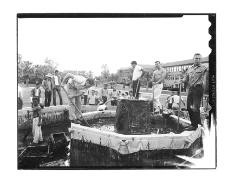Opinion: From the Chief
When programs are being cut and people are in danger of losing their jobs, it’s pretty tough to get worked up over the elimination of flowers and fountains from our campus as a cost-saving measure. Yet I have to admit that I was pretty upset when I read in Monday’s paper that the UA had shut down water features around campus and decided not to replant most of our flowerbeds.
See, there are a lot of reasons why I considered attending the UA, but I knew this was the place for me the first time I set foot on this campus.
The brick, the palm trees, the grass of the mall, the sense of history and tradition around every corner – I don’t know where I developed my mental concept of what a university was supposed to be, but other than Harvard (where I knew I wasn’t going to be going to college), the UA fit it better than anyplace I’d ever been.
And a year or so after I became a student, I became an Arizona Ambassador, which allowed me many happy hours telling the early history of the school in the shade next to the Berger Memorial Fountain outside Old Main. All the while observing future freshmen and their families marveling at weather that was in some cases 60 or 70 degrees warmer than their homes.
So when I read that the sun-drenched green glow of our school was going to dim a bit, I took it kind of personally. No matter what kind of day I’m having, whether I’m lacking sleep or running late to our daily budget meeting, my walk across campus always lifts my spirits and darkens my perpetual farmer’s tan. Yet who can argue that money should be spent on luxuries like landscaping when times are so tough?
But as I’ve pondered the situation over the past couple of days, I’ve found myself thinking of the black and white pictures I’ve seen while thumbing through the archives of the Wildcat.They show a campus even more startlingly verdant than today’s, drawing a sharp contrast between the oasis on one side of the old rock wall and the true desert that surrounds it.
Then I remembered an item I’d seen in the 1955 Desert, the UA’s yearbook. During the 1950s, the Interfraternity Council held what they called Help Week, where pledges from all fraternity chapters on campus “”volunteered”” for a week of service activities around Tucson, and in the fall of 1954, their major project was cleaning and restoring the fountain outside Old Main.
A quick trip to the Special Collections wing of the Main Library revealed that the project had been undertaken at least twice by the IFC, with ample photographic evidence, and I started wondering: Couldn’t we do something like that again?
Students are already going to be doing a lot of the heavy lifting in terms of the budget crisis by paying higher tuition and fees, so why not do a little physical heavy lifting as well? Campus groups – not just Greek Life, but also hall councils, religious groups and service clubs – could adopt little pieces of the campus to see that the beauty of our surroundings remain untarnished, just as our increased tuition payments will see that the quality of our education remains excellent. It’s not our job, of course, but perhaps we could show our elders up in Phoenix what investment really means.
I ran the idea past Chris Kopach, the associate director of UA Facilities Management, and he brought me back down to earth – but only a little.
“”It’s something we looked at a few years ago as part of the creation of the Campus Arboretum,”” Kopach told me. “”We talked about having garden clubs and groups like that take over some of the plantings, (like) the rose gardens by the agriculture building and by the main gate, but the idea just kind of fizzled.””
“”There are definitely some creative things we can do,”” Kopach said – but then he tempered things by saying that some of their efforts in working with student groups in the past hadn’t fared so well, mainly due to lack of commitment. He also called back a bit later and said that even if groups were to adopt planting and maintenance themselves, there would still be the issue of irrigation costs.
Even so, with a little fundraising and creative thinking, I could easily see the flowerbeds in front of the Student Union Memorial Center adopted by Delta Gamma or the Canterbury club, or money for the repair of the Memorial Fountain coming from the resourceful men of Tau Kappa Epsilon.
“”The facilities folks are very loyal to the university, just like the students,”” Kopach said. “”We want people to feel comfortable here in our oasis in the desert. I’ve told (the employees) that we’ll get through this together.””
Maybe the student body should offer to shoulder a little of the burden.
Nickolas Seibel is the editor in chief of the Daily Wildcat. He can be reached at 621-7579 or at editor@wildcat.arizona.edu.









